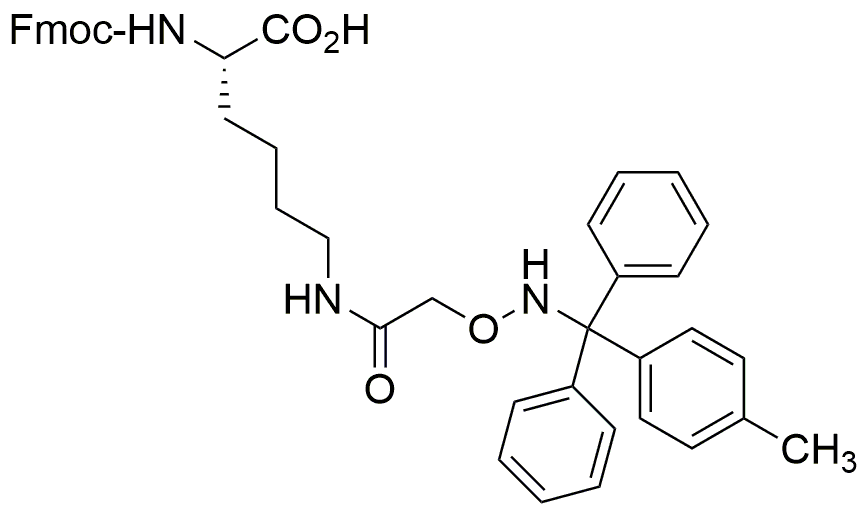Na -Fmoc- Ne -4-methoxyltrityl-aminooxyacetyl-L-lysine is widely utilized in research focused on:
- Peptide Synthesis: This compound serves as a protective group in peptide synthesis, allowing researchers to selectively modify amino acids without interfering with other functional groups. This is particularly beneficial in creating complex peptides for pharmaceuticals.
- Drug Development: Its unique structure aids in the development of targeted drug delivery systems, enhancing the efficacy of therapeutic agents while minimizing side effects, making it valuable in the pharmaceutical industry.
- Bioconjugation: The compound is used in bioconjugation processes, where it helps attach biomolecules to surfaces or other molecules, facilitating the development of biosensors and diagnostic tools.
- Research in Cancer Therapy: Researchers are exploring its potential in cancer therapy, as it can be used to create compounds that selectively target cancer cells, improving treatment outcomes.
- Materials Science: It finds applications in materials science for creating functionalized polymers that can be used in drug delivery systems or as scaffolds in tissue engineering, showcasing its versatility in various fields.
General Information
Properties
Safety and Regulations
Applications
Na -Fmoc- Ne -4-methoxyltrityl-aminooxyacetyl-L-lysine is widely utilized in research focused on:
- Peptide Synthesis: This compound serves as a protective group in peptide synthesis, allowing researchers to selectively modify amino acids without interfering with other functional groups. This is particularly beneficial in creating complex peptides for pharmaceuticals.
- Drug Development: Its unique structure aids in the development of targeted drug delivery systems, enhancing the efficacy of therapeutic agents while minimizing side effects, making it valuable in the pharmaceutical industry.
- Bioconjugation: The compound is used in bioconjugation processes, where it helps attach biomolecules to surfaces or other molecules, facilitating the development of biosensors and diagnostic tools.
- Research in Cancer Therapy: Researchers are exploring its potential in cancer therapy, as it can be used to create compounds that selectively target cancer cells, improving treatment outcomes.
- Materials Science: It finds applications in materials science for creating functionalized polymers that can be used in drug delivery systems or as scaffolds in tissue engineering, showcasing its versatility in various fields.
Documents
Safety Data Sheets (SDS)
The SDS provides comprehensive safety information on handling, storage, and disposal of the product.
Product Specification (PS)
The PS provides a comprehensive breakdown of the product’s properties, including chemical composition, physical state, purity, and storage requirements. It also details acceptable quality ranges and the product's intended applications.
Certificates of Analysis (COA)
Search for Certificates of Analysis (COA) by entering the products Lot Number. Lot and Batch Numbers can be found on a product’s label following the words ‘Lot’ or ‘Batch’.
*Catalog Number
*Lot Number
Certificates Of Origin (COO)
This COO confirms the country where the product was manufactured, and also details the materials and components used in it and whether it is derived from natural, synthetic, or other specific sources. This certificate may be required for customs, trade, and regulatory compliance.
*Catalog Number
*Lot Number
Safety Data Sheets (SDS)
The SDS provides comprehensive safety information on handling, storage, and disposal of the product.
DownloadProduct Specification (PS)
The PS provides a comprehensive breakdown of the product’s properties, including chemical composition, physical state, purity, and storage requirements. It also details acceptable quality ranges and the product's intended applications.
DownloadCertificates of Analysis (COA)
Search for Certificates of Analysis (COA) by entering the products Lot Number. Lot and Batch Numbers can be found on a product’s label following the words ‘Lot’ or ‘Batch’.
*Catalog Number
*Lot Number
Certificates Of Origin (COO)
This COO confirms the country where the product was manufactured, and also details the materials and components used in it and whether it is derived from natural, synthetic, or other specific sources. This certificate may be required for customs, trade, and regulatory compliance.


